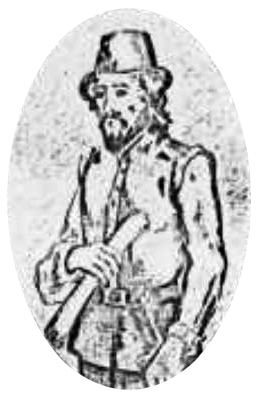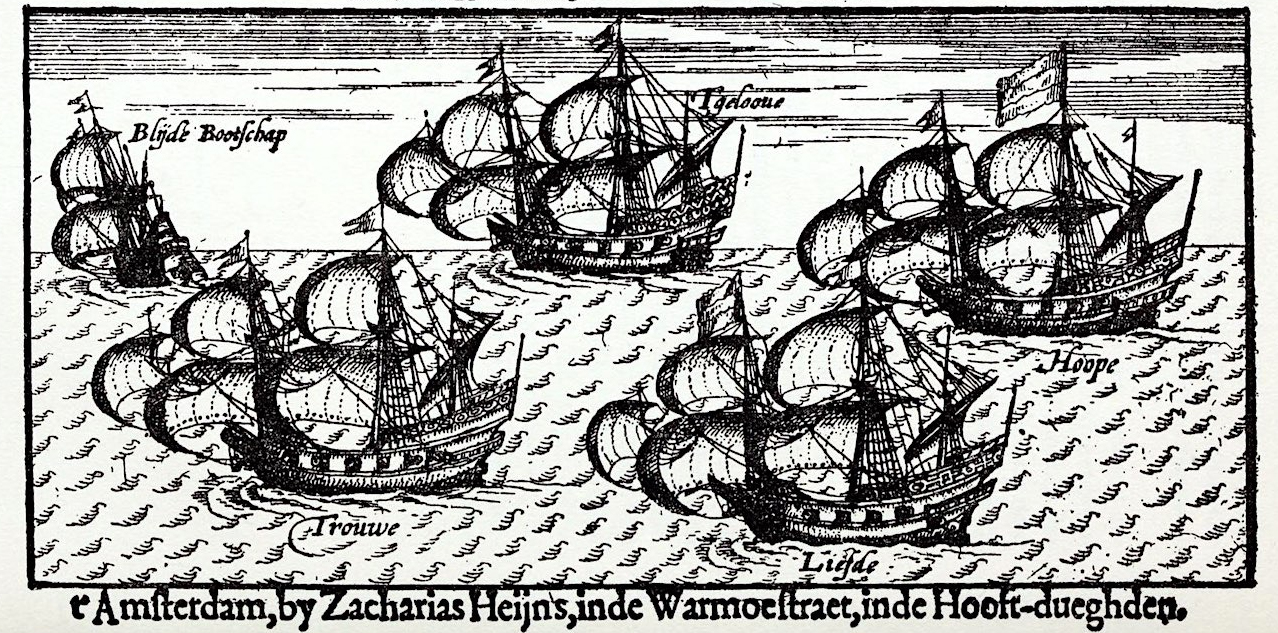 On 16th March 1600 William Adams, Pilot-Major of
a Dutch trading fleet to the far East, was brought before Tokugawa Ieyasu, who
was preparing to make himself master of Japan. Adams and his companions on the
Liefde had been shipwrecked on Japanese shores, in Usuki Bay in Kyushu. The
ship’s cargo of matchlocks, cannonballs, chain shot and fire arrows had been
confiscated along with the ship.
On 16th March 1600 William Adams, Pilot-Major of
a Dutch trading fleet to the far East, was brought before Tokugawa Ieyasu, who
was preparing to make himself master of Japan. Adams and his companions on the
Liefde had been shipwrecked on Japanese shores, in Usuki Bay in Kyushu. The
ship’s cargo of matchlocks, cannonballs, chain shot and fire arrows had been
confiscated along with the ship.
Adams spoke some Portuguese and spoke to Ieyasu through a
Portuguese speaking Japanese interpreter. Having been informed, by the
Spaniards and Portuguese, that the ships in the fleet were pirates Ieyasu
demanded an explanation from Adams, of the purpose of the fleet. The Dutch were
keen to trade; the Spaniards and Portuguese did not want competitors in the highly
lucrative markets in the Far East.
Early Life
William Adams was born in Gillingham in Kent on 24th
September 1564. He was apprenticed to shipyard owner Nicholas Diggins at
Limehouse, in London, at the age of 12 following the death of his father. For
the next twelve years he learned the arts of shipbuilding, astronomy and
navigation. Diggins, who provided many of the gentlemen adventurers with their
ships, taught Adams how to build small, fast caravel built ships; showing him
how to shape a ship’s frame and plank it.
The skills of being a sailor were changing dramatically and
Adams probably studied the book ‘A Regiment for the Sea’ by William Bourne,
teaching pilots how to find their latitude using a cross-staff and a mariner’s
ring and attempting to work out longitude. Other books too taught new skills
for the mariner.
He later sailed under the command of Sir Francis Drake and
captained the supply ship the Richard Duffield, during the attempted Armada
invasion of 1588. Adams married his sweetheart Mary Hyn in Stepney, a few
months after the trouncing of the Spanish. After this, he worked for the
Barbary (or Morocco) Company[i] established by Queen
Elizabeth in 1585. The work could be dangerous as the routes were contested by
pirates and the Turkish authorities treacherous.
Pilot-Major
In the spring of 1598 Adams, along with his brother Thomas,
signed on as Pilot-Major for a fleet of five Dutch ships; the Liefde, the Hoop,
the Geloof, the Trouw and the Blidje Boodschap. The fleet was to sail to South
America and exchange their cargo for silver. If this failed they were to sail
on to Japan, sell the cargo for silver and then buy spices in the Moluccas. Adams
left his wife and daughter, Deliverance, when he signed on; Mary Adams must
have been used by now to having her husband absent for much of the time.
The admiral of the fleet Jacques Mahu asked Adams to serve
as pilot of his ship, the Hoop, while Thomas served on the Trouw. In June
Adams, his brother and eleven other Englishmen boarded the ships. Adams took
his world map, brass globe, astrolabe and compass. Thomas Shotten, one of the
other Englishmen on board the fleet, had already circumnavigated the globe with
Thomas Cavendish in 1586, and was a source of information for Adams.
The fleet set sail on 24th June; the Spanish
suspected that one of the unnamed goals of the voyage was to attack Spanish
possessions abroad for treasure trove.
‘We
set saile with five ships……and departed from the coast of England the fifth of
July’[ii]
wrote Adams, who at some point during the voyage transferred
to the Liefde.
The provisions had been dished out too open-handedly for the
first weeks of the voyage and re-provisioning was necessary before the Straits
of Magellan were attempted. The fleet was sailing down the coast of Africa and
the Portuguese had a heavily defended presence on the coast. It was decided to
attempt a re-provisioning from the Cape Verde islands, but the Portuguese
officials refused to deal with Protestant pirates, until the return of the
Governor[iii].
The sailors attacked and overran a Portuguese fort, which
merely antagonised the Portuguese authorities. The Governor ordered the fleet
to sail off without the much needed supplies. On 22nd September the fleet
was informed that admiral Jacques Mahu had died of a fever; he was replaced by
his deputy Simon de Cordes. The required supplies were still unforthcoming when
the fleet landed on the coast of equatorial Africa.
The fleet set sail for the coast of South America on 2nd
January 1599; without being able to replenish supplies. The ships had been
weakened by the months in tropical waters. Becalmed in the Doldrums, rations
were again cut and the crews came down with scurvy. It was not until the end of
March that the ships sighted land. It was decided to sail through the Straits
of Magellan, to take advantage of the shelter it afforded, in the oncoming
southern winter.
To the Pacific
Adams wanted to sail through the Straits as soon as possible
to avoid the risk of being frozen in, but the sight of penguins was too much
for the hungry crews, who within minutes of landing had clubbed down over 1,400
birds. It was decided that the now freezing waters were too dangerous to sail,
although Adams believed he could pilot the fleet through the Straits. Food
supplies remained desperately low and the expedition ran short of firewood.
The fleet encountered the distinctly unfriendly natives at
the beginning of May; late May five Dutchmen were captured by the ‘wild men’
who tore three of their captives limb from limb[iv]. The temperatures started
to climb in August and by early September the fleet again set sail towards the
Pacific. Many of the crew had died of hunger; the Geloof lost seventy two men
alone. Adams wrote
‘We
came into the South Sea…..were, sixe or seven days after, in a greater storme.’[v]
The fleet was dispersed; Cordes had arranged a meeting point
in Peru, in the event of such a happening. The Blidje Boodschap was captured by
the Spanish; the crew of the Geloof decided to make for home. The crew of the
Trouw decided to make for the Spice Islands and were captured by the
Portuguese.
After being blown off course the Liefde eventually made
landfall at the rendezvous in November 1599. These natives too were unfriendly[vi] but eventually agreed to
trade. But when going ashore the Captain and twenty three of the crew
(including Thomas Adams) were met by an ambush of more than one thousand
Indians. The majority of those going ashore, including Thomas, were killed.
Leaving the benighted place for the island of St Maria the
Liefde caught up with the Hoop. The Spanish agreed to re-victual the ships
after two of their compliment were taken hostage. At a meeting of the senior
officers it was agreed that the two ships would make for Japan, where there was
the possibility of trading the broadcloth in the holds of the Liefde. At the
end of November the ships departed on what was to be an epic voyage.
En Route to Japan
Mid-ocean on nearing some islands[vii] eight sailors took a
pinnace and landed. They were abandoned to their fate as those left on the two
ships were too weak to go after the deserters. The weather now turned against
the voyagers and a great storm blew up
‘We
had a wondrous storme of winde as ever I was in, with much raine.’[viii]
During the storm the Hoop went down in seconds, with the
loss of all aboard. The sinking of the Hoop further accentuated the sense of
despair held by the men. Food was scarce and scurvy and dysentery rife.
‘Great
was the misery we were in, having no more but nine or ten able men to go or
creepe upon their knees……our captain and all the rest looking every hour to
die.’[ix]
But on 12th April 1600 the Liefde made landfall
in Japan.
‘So
we, in safety, let fall our anker, about a league from a place called Bungo.’[x]
Bibliography
Samurai William – Giles Milton, Hodder & Stoughton 2002
The Maker of Modern Japan – AL Sadler, Charles E Tuttle
Company 1983
Tokugawa Ieyasu Shogun – Conrad Totman, Heian 1983
En.wikipedia.org
[i] The company was to enjoy a 12 year monopoly on the trade between England and Morocco
[ii]
Samurai William - Milton
[iii]
Absent at the time
[iv]
The remaining two were rescued by their shipmates under the leadership of de
Cordes.
[v]
Samurai William - Milton
[vi]
The Golden Hind had been met with unfriendly treatment here.
[vii]
Possibly Hawaii
[viii]
Samurai William - Milton
[ix]
Ibid
[x]
Ibid



No comments:
Post a Comment
Note: only a member of this blog may post a comment.